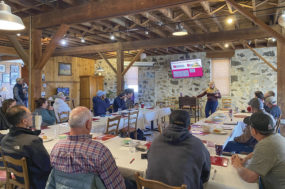New Plymouth High School’s current ag building was built in the 1940s and was intended as the classroom for a much smaller student enrollment. Now the school has seven ag classes per day with more than 160 kids enrolled. The ag program’s "one-room schoolhouse" is about to get a significant upgrade.
The school was recently awarded a $2.27 million grant from Idaho’s Career Ready Students (ICRS) grant fund. The ICRS committee received more than $100 million in requests and funded more than $20 million in projects, including New Plymouth’s project and a new ag building at Minico High School in Rupert, Idaho.
New Plymouth’s grant money will be paired with an in-kind donation from R & M Steel Company for the design and manufacture of the new building. The building should be built and in use by 2025.
“The donation was the keystone that really got us to finalization and approval for that grant, and we are very fortunate to be selected,” says Chase Shoemaker, ag teacher at New Plymouth High School.
Shoemaker is most excited for the additional space for his welding program. He has 76 kids in his welding classes, but he only has enough 220-volt outlets for five students to weld at any one time. He’s using portable generators and temporary outdoor space to give as many students as possible a chance to learn.
“If it’s nice weather we’ll work outside, but all winter long we are indoors. We spend a lot of time during the school year cramped inside the shop because of adverse weather conditions,” Shoemaker says.
His current classroom is 1,000 square feet, and his ag shop is 38 feet by 60 feet – about half the size of a football end zone. One of the welding projects the students work on each year is building a barbecue grill on a flatbed trailer. Once he pulls a flatbed trailer into the shop, there isn’t much room to maneuver around it.
“It really fills up our current shop fast,” Shoemaker says. “The new facility will allow us to spread out a little bit and allow the ag fabrication students to build larger and more challenging projects.”
The new building will be 80 feet by 120 feet – more than three times the size of the current facility. The building’s design is intended to be “low maintenance and last for generations,” says Robert Roberts, president of R & M Steel Company. R & M Steel Company is donating the preengineered metal building, complete with metal wall panels and a standing seam metal roof. The exterior finish will be 3-foot masonry and metal wall panels. The building will be well-insulated for student and teacher comfort.
“For the next 50 years or more, this building is going to look gorgeous and do what everybody wants it to do,” Roberts says.
Construction on the building could begin as early as this summer and is estimated to take six months to complete.
“Quality education and career success are our program’s priorities. And currently we’re not as efficient as we could be at meeting those priorities,” Shoemaker says. “This new building will significantly improve students’ quality of learning and allow expansion of the welding and meats certification programs.”
.jpg?t=1713304395&width=1080)







